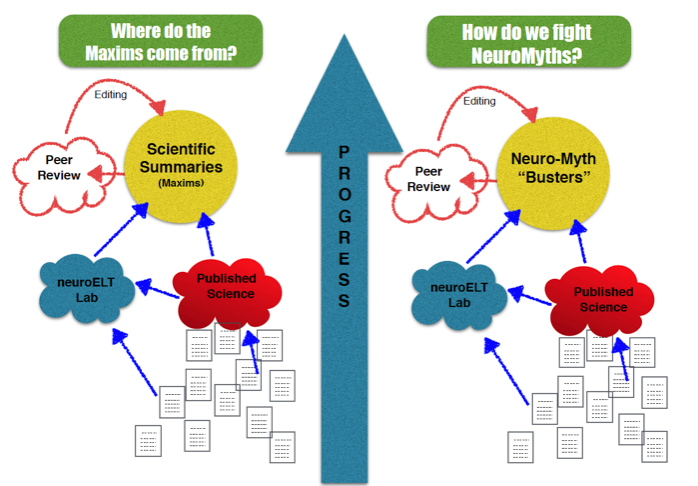The 50 Proposed Maxims for ELT
Fifty is a large number. Take them one at a time. Think about each one deeply. Consider how each one can be applied in the classroom and various other learning/teaching contexts. Take notes of your thoughts. These notes will be very useful for before, during, and after the conference!
Fifty is a large number. Take them one at a time. Think about each one deeply. Consider how each one can be applied in the classroom and various other learning/teaching contexts. Take notes of your thoughts. These notes will be very useful for before, during, and after the conference!


Note: Science is progressive! Connecting these maxims to better teaching is our ultimate goal -- so these maxims are not to be regarded as dogma, but as a springboard for further discovery!
We have spent the past several years synthesizing hundreds of books and scientific articles in and around the fields of neuroscience, psychology, and education.
We then found the most common findings among them, made them practical for the classroom teacher, and then boiled them down into these bite-sized nuggets, in the spirit of Ben Franklin's Poor Richard's Almanack.
We have spent the past several years synthesizing hundreds of books and scientific articles in and around the fields of neuroscience, psychology, and education.
We then found the most common findings among them, made them practical for the classroom teacher, and then boiled them down into these bite-sized nuggets, in the spirit of Ben Franklin's Poor Richard's Almanack.
However, our work is far from finished! We are constantly working on this list and eagerly seek your feedback on them; this is a dynamic and collaborative effort!
The first step is to think about and learn the proposed maxims.
The next steps are to talk about them with someone (use the forum), test your maxims-based ideas based in your classroom.
If you want to see the research behind the maxims, please visit our Maxim Forum. There, you can suggest new research or share feedback on the maxims —let’s build the next Maxims list together!
This is how we see neuroELT growing dynamically: it is a constant dialogue between teachers and researchers, creating a positive cycle of learning and growth… and we are so glad to have you with us!
The first step is to think about and learn the proposed maxims.
The next steps are to talk about them with someone (use the forum), test your maxims-based ideas based in your classroom.
If you want to see the research behind the maxims, please visit our Maxim Forum. There, you can suggest new research or share feedback on the maxims —let’s build the next Maxims list together!
This is how we see neuroELT growing dynamically: it is a constant dialogue between teachers and researchers, creating a positive cycle of learning and growth… and we are so glad to have you with us!


Click on the blue section titles. Visit the Maxim Forum to see the science behind each maxim!
Maxims 1-10
1. “Emotion” drives learning (teacher training video)
2. “Intelligence” is overrated
3. “Cognition” is context dependent. (teacher training video)
4. “Learning” is not understanding. (teacher training video)
5. “Understanding” is the synthesis and application of learning.
6. “Reflexes” compound into action skills.
7. “Action Skills” compound into representations, and then abstract thoughts.
8. “Cognitive development” is age dependent and domain specific. (teacher training video)
9. "Knowledge" is non-transferable. (teacher training video)
10. “Memory” is a process, a myth, and a metaphor
Click on the blue section titles
Maxims 11-21
11. “Teaching” should be differentiated and conducted in high support contexts.
12. “Regression” is a natural component of growth.
13. “Choices” fuel learner motivation. (teacher training video)
14. “Prediction” is a tremendously powerful tool (teacher training video)
15. “Realtime feedback” is at the core of cognitive development
16. “Aha moments” enhance neural networks. (teacher training video)
17-A. “Plastic” is the brain, and why we learn
17-B. “Lose” what you don't use
18. “Alignment” delivers us from chaos. (teacher training video)
19. “Happy students” learn better.
20. “Sleep” is necessary for memory.
21. "Sleeping on a problem” raises your chances of solving it.
Click on the blue section titles
Maxims 22-30
22. No "bias”? No learning!
23. "Solvable mysteries" are the building blocks of understanding.
24. "Performances of Understanding” are essential for good assessment.
25. "Assess" in three ways.
26. "Comforting" solutions are the chosen solutions, even if they are false.
27. "Needs" are unknown; stay flexible.
28. "Rigidity" produces dissonance, the root of stress.
29. "Varying" helps recall.
30. "Creativity" delivers us from ruts. (teacher training video)
Click on the blue section titles
Maxims 31-50
31. "Surprise" me; surprise yourself.
32. "Graphically" organize.
33. Decide upon "top-down" and "bottom-up" teaching ratios. (teacher training video)
34. "Personalize" the content to captivate students. (teacher training video)
35. “Room temperature” matters!
36. “Lighting conditions” matter!
37. "Healthy" bodies make healthy brains; healthy brains make healthy bodies. (teacher training video)
38. Establish "Active" break times.
39. "Meditate" for better learning; go into default mode.
40. "Spice" up your classroom by engaging other senses
41. Encourage "mistakes”; celebrate mistakes.
42. Teach for the "DATC”.
Click on the blue section titles
---- The Newer Maxims:
43. The earlier, the better. Monolingualism is the minority.
44. Balanced bilinguals have an L1 self and an L2 self.
45. Bilinguals use different neural networks per language, but there is overlap.
46. Shy does not mean introvert; introvert does not mean shy.
47. Collaboration boosts levels of cognition.
48. The "labeling" of high-level concepts is a double-edged sword..
49. Don’t forget to “Rhyme”.
50. Language is an "emergent property"; It is a tool for equilibrium with the world in which we navigate.
Visit the Maxim Forum to see the science behind each maxim!
1. “Emotion” drives learning (teacher training video)
2. “Intelligence” is overrated
3. “Cognition” is context dependent. (teacher training video)
4. “Learning” is not understanding. (teacher training video)
5. “Understanding” is the synthesis and application of learning.
6. “Reflexes” compound into action skills.
7. “Action Skills” compound into representations, and then abstract thoughts.
8. “Cognitive development” is age dependent and domain specific. (teacher training video)
9. "Knowledge" is non-transferable. (teacher training video)
10. “Memory” is a process, a myth, and a metaphor
Click on the blue section titles
Maxims 11-21
11. “Teaching” should be differentiated and conducted in high support contexts.
12. “Regression” is a natural component of growth.
13. “Choices” fuel learner motivation. (teacher training video)
14. “Prediction” is a tremendously powerful tool (teacher training video)
15. “Realtime feedback” is at the core of cognitive development
16. “Aha moments” enhance neural networks. (teacher training video)
17-A. “Plastic” is the brain, and why we learn
17-B. “Lose” what you don't use
18. “Alignment” delivers us from chaos. (teacher training video)
19. “Happy students” learn better.
20. “Sleep” is necessary for memory.
21. "Sleeping on a problem” raises your chances of solving it.
Click on the blue section titles
Maxims 22-30
22. No "bias”? No learning!
23. "Solvable mysteries" are the building blocks of understanding.
24. "Performances of Understanding” are essential for good assessment.
25. "Assess" in three ways.
26. "Comforting" solutions are the chosen solutions, even if they are false.
27. "Needs" are unknown; stay flexible.
28. "Rigidity" produces dissonance, the root of stress.
29. "Varying" helps recall.
30. "Creativity" delivers us from ruts. (teacher training video)
Click on the blue section titles
Maxims 31-50
31. "Surprise" me; surprise yourself.
32. "Graphically" organize.
33. Decide upon "top-down" and "bottom-up" teaching ratios. (teacher training video)
34. "Personalize" the content to captivate students. (teacher training video)
35. “Room temperature” matters!
36. “Lighting conditions” matter!
37. "Healthy" bodies make healthy brains; healthy brains make healthy bodies. (teacher training video)
38. Establish "Active" break times.
39. "Meditate" for better learning; go into default mode.
40. "Spice" up your classroom by engaging other senses
41. Encourage "mistakes”; celebrate mistakes.
42. Teach for the "DATC”.
Click on the blue section titles
---- The Newer Maxims:
43. The earlier, the better. Monolingualism is the minority.
44. Balanced bilinguals have an L1 self and an L2 self.
45. Bilinguals use different neural networks per language, but there is overlap.
46. Shy does not mean introvert; introvert does not mean shy.
47. Collaboration boosts levels of cognition.
48. The "labeling" of high-level concepts is a double-edged sword..
49. Don’t forget to “Rhyme”.
50. Language is an "emergent property"; It is a tool for equilibrium with the world in which we navigate.
Visit the Maxim Forum to see the science behind each maxim!
Check back soon for our newest scientific write-ups on each of these maxims!



